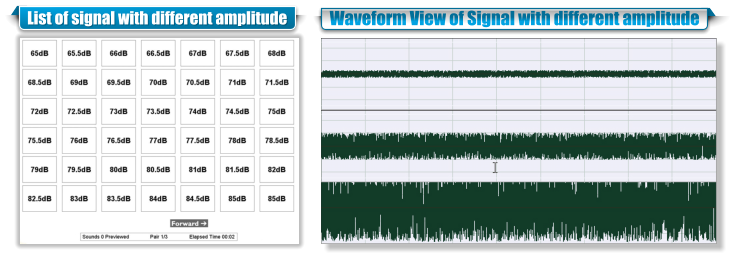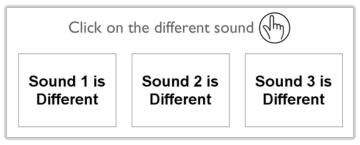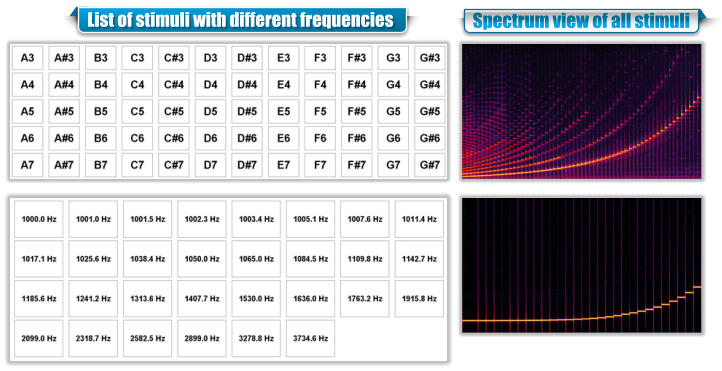

The Auditory Resolution Training Module provides you with the opportunity to listen to and
distinguish sounds differed in one specific domain, such as spectral, temporal, and amplitude etc.
This training group is aimed at improving the ability to discriminate the subtle acoustic difference
among these sound, thus improving speech understanding. This training module covers frequency
discrimination, modulation detection, temporal gap detection, amplitude discrimination, forward
masking, and pure tone detection.
Group 1: Frequency Discrimination Training
The Frequency Discrimination Group provides you with the opportunity to listen to and distinguish sounds differed
in the frequency domain. This training group is aimed at improving the ability to discriminate the subtle frequency
difference among these sound, thus improving speech understanding. The first three tasks are targeted at music
notes while the last one is targeted at 1kHz pure tone. 3AFC (3 alternative forced choice) will be used for all
auditory resolution training. In this protocol, the computer will play three sounds, the listener has to identify which
sound is different from the other two. The difference (in this case, frequency) between the reference and target
signal will be adaptively adjusted according to the response of the listener. Basically, the difference will be
gradually reduced when the response is correct and increased when the resposne is not correct.
Group 2: Modulation Detection Training
The Modulation Detection Group provides you with the opportunity to listen to and distinguish sounds differed in
the temporal modulation. This training group is aimed at improving the ability to discriminate the subtle temporal
flunctuation difference among these sound, thus improving speech understanding. All five tasks are similar except
that the modulation frequency is different (10, 20, 50, 100, and 200 Hz).
Stimuli for all signals with different modulation depth. No=no modulation; -40=1% of modulation depth; 0=100% of
modulation depth.
Group 3: Modulation Frequency Discrimination
The Modulation Frequency Discrimination Group provides you with the opportunity to listen to and distinguish
sounds differed in the temporal modulation. This training group is aimed at improving the ability to discriminate the
subtle temporal flunctuation difference among these sound, thus improving speech understanding. All five tasks
are similar except that the modulation frequency is different (10, 20, 50, 100, and 200 Hz).
Stimuli for all signals with different modulation frequency:
Group 4: Temporal Gap Detection Training
The Temporal Gap Detection Group provides you with the opportunity to listen to and distinguish sounds with gap
in between. This training group is aimed at improving the ability to discriminate the subtle temporal gap among the
signals, thus improving speech understanding. The gap is located in the middle of two signals. These signals can
be the same or different. Three signals are used, including noise, 1kHz, and 2kHz pure tones.
Stimuli for signals with different gaps: Waveform for signals with different gaps:
Group 5: Amplitude Discrimination Training
The Amplitude Discrimination Group provides you with the opportunity to listen to and distinguish sounds with
different levels. This training group is aimed at improving the ability to discriminate the subtle amplitude difference
among the signals, thus improving speech understanding. Three signals are used, including noise, 1kHz, and
2kHz pure tones.
Group 6: Tone Detection with Masker (Forward Masking) Training
The Tone Detection with Masker Group provides you with the opportunity to listen to and distinguish sounds when
there is a masking signal . This training group is aimed at improving the ability to detect a sound when there is an
interefering signal, thus improving speech understanding. The masker is white noise while the probe signal is a
1kHz tone. The gap between betwen masker and probe varies from 10ms to 100ms.
Group 7: Puretone Threshold Detection Training
The Pure Tone Threshold Group provides you with the opportunity to listen to and detect very weak sounds. This
training group is aimed at improving the ability to detect a weak sound, thus improving speech understanding.
Five different pure tones are used in this group, including 250, 500, 1000, 2000, and 4000 Hz.
Group 8: Music Rhythm Test and Training
The Music Rhythm Test and Training Group provides you with the opportunity to listen to and distinguish musical
rhythms in a melodic sequence. This training group is aimed at improving the ability to listen to the subtle rhythmic
changes, thus improving music appreciation. All six tasks are similar except that the change occurs in 2nd or 3rd
notes with either flat, rising, or falling note patterns.
List of stimuli with different gaps Waveform view of contours with different rhythms



































